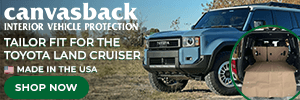- Jun 8, 2024
- 436
- Media
- 44
- 837
- Vehicles
- 2007 Toyota Tundra 4X4 Double Cab 5.7L V8, 2015 Chevrolet SS LS3 V8
For the OP:
A link to Toyota PDF of the 2024 Toyota Land Cruiser maintenance guide.
One thing to note: spark plugs are due every 40,000 miles!
Otherwise take the oil change intervals and cut them in half. Every 5K miles.
Personally at 10-15K miles I would dump out the front and rear axle gear oil and replace it with the highest quality synthetic gear oil I could lay my dirty mitts on. Same for the transfer case. Get the original factory fill out of there to get rid of all the particulate matter from the gear sets burnishing in with one another during break in. The gear oil will probably look like hell the first time. After that you can run a good synthetic gear oil for a shockingly long time in an axle or transfer case and have it pour out 100K later looking like it’s damn near new.
The lifetime transmission fluid fill is total horse shit if you plan to hold the vehicle a long time. Drain the trans pan and refill every 60K and you’ll boost the longevity of the 8 speed to never need to worry about it unless you get it hot. If you ever get the transmission hot, do not keep that fluid in there get it all changed out ASAP just don’t do a pressurized flush out. If you plan to tow regularly or do a lot of low speed off road driving or you live in a hot area adding a stand alone transmission cooler will help your transmission out a lot.
As pointed out if the driveshaft and slip yoke have grease zerks use them.
A link to Toyota PDF of the 2024 Toyota Land Cruiser maintenance guide.
One thing to note: spark plugs are due every 40,000 miles!
Otherwise take the oil change intervals and cut them in half. Every 5K miles.
Personally at 10-15K miles I would dump out the front and rear axle gear oil and replace it with the highest quality synthetic gear oil I could lay my dirty mitts on. Same for the transfer case. Get the original factory fill out of there to get rid of all the particulate matter from the gear sets burnishing in with one another during break in. The gear oil will probably look like hell the first time. After that you can run a good synthetic gear oil for a shockingly long time in an axle or transfer case and have it pour out 100K later looking like it’s damn near new.
The lifetime transmission fluid fill is total horse shit if you plan to hold the vehicle a long time. Drain the trans pan and refill every 60K and you’ll boost the longevity of the 8 speed to never need to worry about it unless you get it hot. If you ever get the transmission hot, do not keep that fluid in there get it all changed out ASAP just don’t do a pressurized flush out. If you plan to tow regularly or do a lot of low speed off road driving or you live in a hot area adding a stand alone transmission cooler will help your transmission out a lot.
As pointed out if the driveshaft and slip yoke have grease zerks use them.
Last edited:


